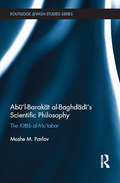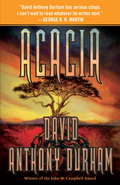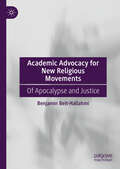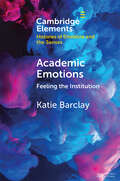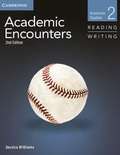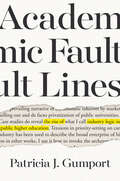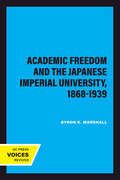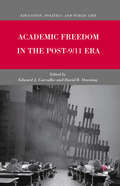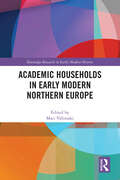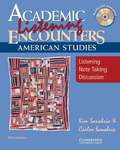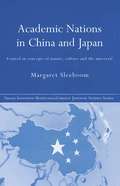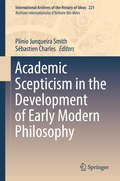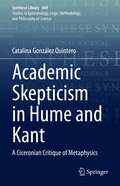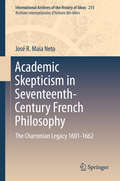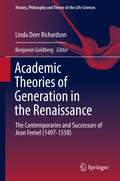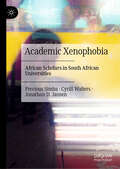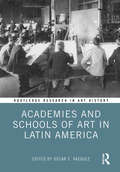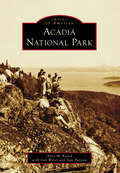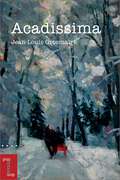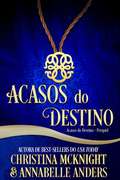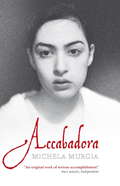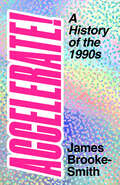- Table View
- List View
Abū’l-Barakāt al-Baghdādī’s Scientific Philosophy: The Kitāb al-Mu‘tabar (Routledge Jewish Studies Series)
by Moshe M. PavlovAbū’l-Barakāt is often considered one of the most comprehensive philosophers of the Arabic-Jewish milieu in the medieval age. His extensive and unique philosophical theories, especially his theories in the particular sciences, were seen as a major challenge for the traditional conceptions of the Aristotelian school of thought during and after this period. ‘Abū’l-Barakāt al-Baghdādī’s Scientific Philosophy’ explores the core material of Abū’l-Barakāt’s scientific studies, found in his magnum opus the Kitāb al-Mu‘tabar. The book then locates these scientific theories within Abū’l-Barakāt’s philosophy more widely. Whilst providing a comprehensive critique of ancient philosophy, including the work of Aristotle, certain affinities between Abū’l-Barakāt’s work and that of more modern scientific conceptions are also examined. Containing vast amounts of previously untranslated text, ‘Abū’l-Barakāt al-Baghdādī’s Scientific Philosophy’ sheds new light on the philosopher’s scientific theories, particularly with regards to his logical conceptions. For this reason, the book will be a valuable resource for students and scholars of Jewish and Islamic Philosophy, whilst the scientific material will appeal to those studying the history of science.
Acacia: The Acacia Trilogy, Book One (Acacia Trilogy #1)
by David Anthony Durham"David Anthony Durham has serious chops. I can't wait to read whatever he writes next."--George R. R. MartinWelcome to Acacia . . . Born into generations of prosperity, the four royal children of the Akaran dynasty know little of the world outside their opulent island paradise. But when an assassin strikes at the heart of their power, their lives are changed forever. Forced to flee to distant corners and separated against their will, the children must navigate a web of hidden allegiances, ancient magic, foreign invaders, and illicit trade that will challenge their very notion of who they are. As they come to understand their true purpose in life, the fate of the world lies in their hands.
Academia and Trade: The Numismatic World in the Long Nineteenth Century, Volume 1 (Routledge Studies in Cultural History)
by Stefan Krmnicek Hadrien RambachThis first part of a 2-volume collection comprises a collection of essays in English by leading scholars on the 19th-century Academia and Trade presenting the latest developments in international scholarship on the numismatic world in the long 19th century. In the 19th century, developments in the study and collection of coins set the cornerstone for modern numismatics. This volume comprises a collection of essays in English by international leading scholars that highlight significant figures of the 19th-century research and the state of the numismatic trade in their time. Centering around collectors and scholars of ancient, medieval, and modern numismatics, and on non-Western coinage and medals against the backdrop of the political, cultural, economic, and social changes of the era, this book presents the latest scholarship on numismatics’ contribution to the cultural history of the 19th century. This volume is essential for students and scholars alike interested in 19th -century history and the history of coins.
Academic Advocacy for New Religious Movements: Of Apocalypse and Justice
by Benjamin Beit-HallahmiThis book explores the intersection of advocacy and academic practice within the social sciences, focusing on the ethical dimensions and potential consequences of researchers engaging in political action on behalf of the groups they study. Investigating the ethical and practical implications of advocacy in academic work, specifically within the social sciences. It examines how scholars, guided by their research and vision for social change, engage politically to support the groups they study. The book addresses the debate surrounding academic advocacy: is it harmful or a necessary pursuit? Through a detailed study of a historical advocacy movement, it analyzes the global campaign to gain legitimacy for new religious movements (NRMs) between 1980 and 2000. It is an important read for scholars of New Religious Movements and those interested in the way religion is studied.
Academic Emotions: Feeling the Institution (Elements in Histories of Emotions and the Senses)
by Katie BarclayThe University is an institution that disciplines the academic self. As such it produces both a particular emotional culture and, at times, the emotional suffering of those who find such disciplinary practices discomforting. Drawing on a rich array of writing about the modern academy by contemporary academics, this Element explores the emotional dynamics of the academy as a disciplining institution, the production of the academic self, and the role of emotion in negotiating power in the ivory tower. Using methodologies from the History of Emotion, it seeks to further our understanding of the relationship between the institution, emotion and the self.
Academic Encounters Reading Writing: American Studies
by Janis P. MeekTopics include the foundations of government, equal rights, and the American Dream. Students develop important skills such as skimming, reading for the main idea, reading for speed, understanding vocabulary in context, summarizing, and note-taking. By completing writing assignments, students build academic writing skills and incorporate what they have learned.
Academic Fault Lines: The Rise of Industry Logic in Public Higher Education
by Patricia J. GumportHow did public higher education become an industry? This unprecedented account reveals how campus leaders and faculty preserved the vitality and core values of public higher education despite changing resources and expectations.American public higher education is in crisis. After decades of public scrutiny over affordability, access, and quality, indictments of the institution as a whole abound. Campus leaders and faculty report a loss of public respect resulting from their alleged unresponsiveness to demands for change. But is this loss of confidence warranted? And how did we get to this point? In Academic Fault Lines, Patricia J. Gumport offers a compelling account of the profound shift in societal expectations for what public colleges and universities should be and do. She attributes these new attitudes to the ascendance of "industry logic"—the notion that higher education must prioritize serving the economy. Arguing that industry logic has had far-reaching effects, Gumport shows how this business-oriented mandate has prompted colleges to restructure for efficiency gains, adopt more corporate forms, develop deeper ties with industry, and mold academic programs in the interest of enhancing students' future employment prospects. She also explains how industry logic gained traction and momentum, altering what constitutes legitimacy for public higher education.Yet Gumport's narrative is by no means defeatist. Drawing on case studies of nine public colleges and universities, as well as more than 200 stakeholder interviews, Gumport's nuanced account conveys the successful efforts of leaders and educators to preserve and even strengthen fundamental public values such as educational access, knowledge advancement regardless of currency, and civic responsibility. Ultimately, Academic Fault Lines demonstrates how intrepid faculty and administrators engaged their communities both on and off campus, collaborating and inventing win-win scenarios to further public higher education's expanding legacy of service to all citizens while preserving its centrality to society and the world.
Academic Freedom and the Japanese Imperial University, 1868-1939
by Byron K. MarshallByron K. Marshall offers here a dramatic study of the changing nature and limits of academic freedom in prewar Japan, from the Meiji Restoration to the eve of World War II.Meiji leaders founded Tokyo Imperial University in the late nineteenth century to provide their new government with necessary technical and theoretical knowledge. An academic elite, armed with Western learning, gradually emerged and wielded significant influence throughout the state. When some faculty members criticized the conduct of the Russo-Japanese War the government threatened dismissals. The faculty and administration banded together, forcing the government to back down. By 1939, however, this solidarity had eroded. The conventional explanation for this erosion has been the lack of a tradition of autonomy among prewar Japanese universities. Marshall argues instead that these later purges resulted from the university's 40-year fixation on institutional autonomy at the expense of academic freedom.Marshall's finely nuanced analysis is complemented by extensive use of quantitative, biographical, and archival sources.
Academic Freedom in the Post-9/11 Era (Education, Politics and Public Life)
by Edward J. Carvalho David B. DowningThis timely collection features an impressive assembly of the nation's leading intellectuals, addressing some of the most urgent issues facing higher education in the United States today.
Academic Households in Early Modern Northern Europe (Routledge Research in Early Modern History)
by Välimäki, Edited by MariThis volume explores academic households in early modern (c. sixteenth to eighteenth century) Northern Europe, examining changing dynamics of family and gender.During the Middle Ages, Christian scholars were expected to spend their lives unwed and instead focus on educating the young. However, a gradual easing of prohibitions against the marriage of scholars began in different areas of Europe in the late fourteenth century. By the end of the sixteenth century, a great number of professors were men with families and establishing their own households. This was especially the case in the German-speaking Protestant areas of Europe and the Swedish realm from the first half of the seventeenth century. The contributors of this volume concentrate on universities that took on the new idealised understanding of professors and other members of academic communities as married men. They analyse how professors and other members of the academic communities viewed family and household, what academic family life was like, and how the members of the academic community utilised family and the household for (academic) self-fashioning and building networks. Furthermore, they pay special attention to the wives and widows of professors and other academics and discuss the agency of these women.This book is an excellent resource for students and professional readers alike who are interested in the histories of early modern universities, families, and gender.
Academic Listening Encounters: Listening, Note Taking, Discussion (Intermediate)
by Kim Sanabria Carlos SanabriaThis book engages students through interviews and academic lectures on stimulating topics from the field of American Studies. Topics include civil rights, traditional American values in relation to life today, country music, sports, and the globalization of American slang.
Academic Nations in China and Japan: Framed by Concepts of Nature, Culture and the Universal (Nissan Institute/Routledge Japanese Studies)
by Margaret SleeboomThe descriptions Chinese and Japanese people attribute to themselves and to each other differ vastly and stand in stark contrast to Western perceptions that usually identify a 'similar disposition' between the two nations. Academic Nationals in China and Japan explores human categories, how academics classify themselves and how they divide the world into groups of people.Margaret Sleeboom carefully analyses the role the nation-state plays in Chinese and Japanese academic theory, demonstrating how nation-centric blinkers often force academics to define social, cultural and economic issues as unique to a certain regional grouping. The book shows how this in turn contributes to the consolidating of national identity while identifying the complex and unintended effects of historical processes and the role played by other local, personal and universal identities which are usually discarded.While this book primarily reveals how academic nations are conceptualized through views of nature, culture and science, the author simultaneously identifies comparable problems concerning the relation between social science research and the development of the nation state. This book will appeal not only to Asianists but also to those with research interests in Cultural Studies and Sinology.
Academic Scepticism in the Development of Early Modern Philosophy (International Archives of the History of Ideas Archives internationales d'histoire des idées #221)
by Sébastien Charles Plínio Junqueira SmithThis book explores how far some leading philosophers, from Montaigne to Hume, used Academic Scepticism to build their own brand of scepticism or took it as its main sceptical target. The book offers a detailed view of the main modern key figures, including Sanches, Charron, La Mothe Le Vayer, Bacon, Gassendi, Descartes, Malebranche, Pascal, Foucher, Huet, and Bayle. In addition, it provides a comprehensive assessment of the role of Academic Scepticism in Early Modern philosophy and a complete survey of the period. As a whole, the book offers a basis for a new, balanced assessment of the role played by scepticism in both its forms. Since Richard Popkin's works, there has been considerable interest in the role played by Pyrrhonian Scepticism in Early Modern Philosophy. Comparatively, Academic Scepticism was much neglected by scholars, despite some scattered important contributions. Furthermore, a general assessment of the presence of Academic Scepticism in Early Modern Philosophy is lacking. This book fills the void.
Academic Skepticism in Hume and Kant: A Ciceronian Critique of Metaphysics (Synthese Library #449)
by Catalina González QuinteroThis book offers an unprecedented study of the influence of the skepticism of the New Platonic Academy on David Hume’s and Immanuel Kant’s critiques of metaphysics. By demonstrating how the skeptical teachings of the Academy affected these authors’ Enlightened attacks on traditional metaphysics, this book deepens and broadens the burgeoning scholarship on the role that the Ancients schools of skepticism played in the configuration of Modern skeptical outlooks. It bolsters the newfound recognition that we must reconsider the conventional view that the revival of Pyrrhonism in the sixteenth and seventeenth centuries gave birth to Modern skepticism by incorporating the influence of Academic skepticism in the analysis.Giving a new impetus to this line of research, the author argues that Academic ideas and methods informed Hume’s and Kant’s critique of metaphysics in substantial and thus far unacknowledged ways. Specifically, she demonstrates the centrality of Academic skepticism to Hume’s epistemology and critique of religion through a detailed analysis of his theory of belief in the Treatise and the first Enquiry as well as of its application in the Dialogues concerning Natural Religion. Likewise, her analysis reveals how Kant’s anti-metaphysical stance, developed in the Transcendental Dialectic of the Critique of Pure Reason, contains many skeptical insights of Academic inspiration, bequeathed to him by Hume.
Academic Skepticism in Seventeenth-Century French Philosophy: The Charronian Legacy 1601-1662 (International Archives of the History of Ideas Archives internationales d'histoire des idées #215)
by José R. Maia NetoThis book is the first systematic account of Pierre Charron's influence among the major French philosophers in the period (1601-1662). It shows that Charron's Wisdom was one of the main sources of inspiration of Pierre Gassendi's first published book, the Exercitationes adversus aristoteleos. It sheds new light on La Mothe Le Vayer, who is usually viewed as a major free thinker. By showing that he was a follower of Charron, La Mothe emerges neither as a skeptical apologist nor as a disguised libertine, as combatting superstition but not as irreligious. The book shows the close presence of Charron in the preambles of Descartes' philosophy and that the cogito is mainly based on the moral Academic self-assurance of Charron's wise man. This interpretation reverses the standard view of Descartes' relation to skepticism. Once this skepticism is recognized to be Charron's Academic one, it is seen not as the target but as the source of the cogito. Pascal is the last major philosopher for whom Charron's wisdom is crucially relevant. Montaigne and Descartes influenced, respectively, Pascal's view of the Pyrrhonian skeptic and of the skeptical main arguments. The book shows that Charron's Academic skeptical wise man is one of the main targets of his projected apology for Christianity, since he considered him as a threat and counter-example of the kind of Christian view of human beings he believed. By restoring the historical philosophical relevance of Charron in early modern philosophy and arguing for the relevance of Academic skepticism in the period, this book opens a new research program to early modern scholars and will be valuable for those interested in the history of philosophy, French literature and religion.
Academic Theories of Generation in the Renaissance: The Contemporaries and Successors of Jean Fernel (1497-1558) (History, Philosophy and Theory of the Life Sciences #22)
by Benjamin Goldberg Linda Deer RichardsonThis volume deals with philosophically grounded theories of animal generation as found in two different traditions: one, deriving primarily from Aristotelian natural philosophy and specifically from his Generation of Animals; and another, deriving from two related medical traditions, the Hippocratic and the Galenic. The book contains a classification and critique of works that touch on the history of embryology and animal generation written before 1980. It also contains translations of key sections of the works on which it is focused. It looks at two different scholarly communities: the physicians (medici) and philosophers (philosophi), that share a set of textual resources and philosophical lineages, as well as a shared problem (explaining animal generation), but that nevertheless have different concerns and commitments. The book demonstrates how those working in these two traditions not only shared a common philosophical background in the arts curricula of the universities, but were in constant intercourse with each other. This book presents a test case of how scholarly communities differentiate themselves from each other through methods of argument, empirical investigation, and textual interpretations. It is all the more interesting because the two communities under investigation have so much in common and yet, in the end, are distinct in a number of important ways.
Academic Xenophobia: African Scholars in South African Universities
by Jonathan D. Jansen Precious Simba Cyrill WaltersThis book explores the layered experiences of Black African faculty members at the 26 public universities in South Africa. Through rich narrative case studies and detailed policy analysis, the authors examine the manifestations of xenophobia within the academic context, including its impact on individuals, institutions, and policies. The book will be valuable to scholars, policymakers, and practitioners interested in understanding the evolving landscape of xenophobia, tertiary education, and immigration in South Africa.
Academies and Schools of Art in Latin America (Routledge Research in Art History)
by Oscar E. VázquezThis edited volume’s chief aim is to bring together, in an English-language source, the principal histories and narratives of some of the most significant academies and national schools of art in South America, Mexico, and the Caribbean, from the late 18th to the early 20th centuries. The book highlights not only issues shared by Latin American academies of art but also those that differentiate them from their European counterparts. Authors examine issues including statutes, the influence of workshops and guilds, the importance of patronage, discourses of race and ethnicity in visual pedagogy, and European models versus the quest for national schools. It also offers first-time English translations of many foundational documents from several significant academies and schools. This book will be of interest to scholars in art history, Latin American and Hispanic studies, and modern visual cultures.
Academy Dictionaries 1600-1800
by John ConsidineThis is the first unified history of the large, prestigious dictionaries of the seventeenth and eighteenth centuries, compiled in academies, which set out to glorify living European languages. The tradition began with the Vocabolario degli Accademici della Crusca (1612) in Florence and the Dictionnaire de l'Académie françoise (1694) in Paris, and spread across Europe - to Germany, Spain, England, Denmark, Sweden, the Netherlands, Portugal, and Russia - in the eighteenth century, engaging students of language as diverse as Leibniz, Samuel Johnson, and Catherine the Great. All the major academy and academy-style dictionaries of the period up to 1800, published and unpublished, are discussed in a single narrative, bridging national and linguistic boundaries, to offer a history of lexicography on a European scale. Like John Considine's Dictionaries in Early Modern Europe (Cambridge University Press, 2008), this study treats dictionaries both as physical books and as ambitious works of the human imagination.
Acadia National Park (Images of America)
by Anne M. Kozak Josh Winer Sam PutnamMost histories of Acadia National Park chronicle the contributions of men in acquiring land, and while these contributions were critical, women also played a pivotal role. Some funded memorial paths, others facilitated George Dorr's acquiring land, and still others donated land. For people to enjoy the park and to find respite required developing infrastructure that provided easy access--a goal of Dorr, John D. Rockefeller Jr., and National Park Service directors Stephen Mather and Arno Cammerer. This book examines the role of women, the activities that characterize people enjoying the park, and the development of infrastructure, particularly the bridges and motor roads. Having access to two private photograph collections--those of the van Heerden family and Harold MacQuinn Inc.--as well as the photograph collection of Leo Grossman, the engineer for the Cadillac Mountain Road, has allowed us to use many previously unpublished images.
Acadissima (Essais et fiction)
by Monsieur Jean-Louis GrosmaireAcadie, 1917. Dans un village acadien de bord de mer, où la vie se déploie au fil de ses saisons et de ses luttes, dans sa beauté et son âpreté, Jean-Baptiste, à peine un homme, et la jolie Angelaine s’aiment éperdument. Du jour au lendemain, leur monde bascule du tout au tout. Devenu orphelin en temps de guerre, désemparé, le jeune homme s’enrôle dans l’Armée canadienne et quitte les rivages de son Acadie natale et sa bien-aimée. Il pense partir au front, mais il se retrouve dans les magnifiques montagnes de la Franche-Comté, à y bûcher rudement le bois à coeur de jour. Avec, comme toile de fond, le gigantesque et méconnu travail des soldats canadiens et acadiens durant la Première Guerre mondiale dans le Jura, en Franche- Comté, Acadissima révèle la force de l’amour qui unit deux jeunes Acadiens, malgré la guerre, l’éloignement et la difficulté de vivre. Publié en français.
Acasos do Destino: Prequel - História de Introdução
by Christina McKnightDe Condessa à pária ... Evitada pelo Beau Monde da Inglaterra por sua ascendência ser de Barbados, a Senhorita A'laya Banesworth passou sua vida ansiando pela verdadeira aceitação. Quando o Conde de Holderness a corteja, ela acredita que encontrou o amor verdadeiro. Rapidamente, A'laya descobre que seu casamento é apenas de conveniência. Embora agora seja uma Condessa, A'laya ainda enfrenta a desaprovação e o desprezo da família de seu novo marido. Apenas o nascimento de sua filha, Katherina traz felicidade a sua vida. Mas A'laya não antecipa como seus inimigos são perversos. Katherina é roubada dela, e A'laya fica sem meios de encontrá-la. Ainda assim, a procura desesperadamente, esperando que sua filha ainda esteja viva. Com o passar dos anos, A'laya passa a viajar pelo interior da Inglaterra como cartomante, ansiando por se reunir com Katherina. O laço entre mãe e filha é forte - tão forte que quando o destino e o acaso colidem, o amor transborda ...
Accabadora
by Michela MurgiaOne of Elena Ferrante's best 40 books by female writersWhen Maria, the fourth child of a widow, is adopted by the old and childless Bonaria Urrai, her life is instantly transformed - she finally has the love and affection she craves. But her new 'soul mother' is keeping something hidden from her, a secret life that is intimately bound-up with Sardinia's ancient traditions and customs. Midwife to the dying, easing their suffering and sometimes ending it, she is revered and feared in equal measure as the village's Accabadora. Bonaria tries to shield the girl from the truth about her role as an angel of mercy, until, moved by the pleas of a young man crippled in an accident, she breaks her golden rule of familial consent. The consequences - for Bonaria, for Maria and for the whole village, are devastating - and cause a rift between the two women that can only be bridge by another death.Translated from the Italian by Silvester Mazzarella
Accelerate!: A History of the 1990s
by James Brooke-Smith Jack SmythThe 1990s was the decade in which the Soviet Union collapsed and Francis Fukuyama declared the ‘end of history’. Nelson Mandela was released from prison, Google was launched and scientists in Edinburgh cloned a sheep from a single cell. It was also a time in which the president of the United States discussed fellatio on network television and the world’s most photographed woman died in a car crash in Paris. Radical pop band The KLF burned a million quid on a Scottish island, while the most-watched programme on TV was Baywatch. Anti-globalisation protestors in France attacked McDonald’s restaurants and American survivalists stockpiled guns and tinned food in preparation for Y2K.For those who lived through it, the 1990s glow in the memory with a mixture of proximity and distance, familiarity and strangeness. It is the decade about which we know so much yet understand too little. Taking a kaleidoscopic view of the politics, social history, arts and popular culture of the era, James Brooke-Smith asks – what was the 1990s? A lost golden age of liberal optimism? A time of fin-de-siècle decadence? Or the seedbed for the discontents we face today?
